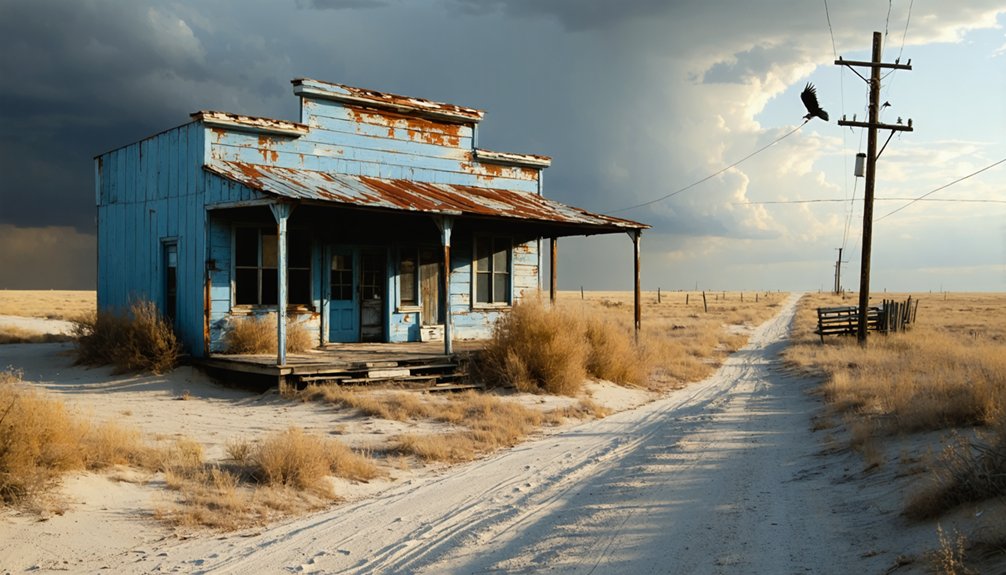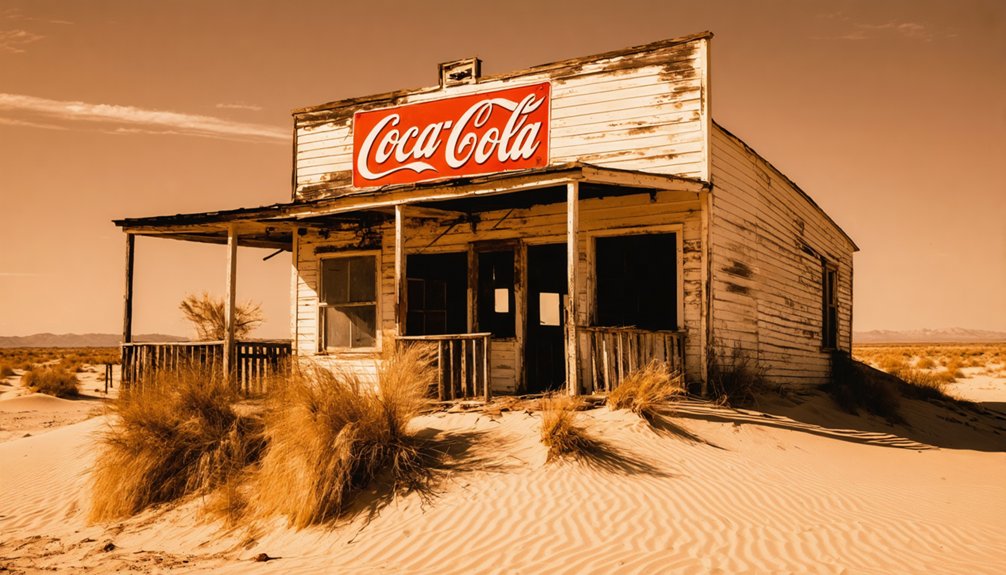You’ll find Sandy Hills ghost town in western Wilson County, Texas, five miles west of La Vernia at the crossroads of County Roads 321 and 361. The 1880s discovery of copper and silver deposits transformed this agricultural settlement into a mining hub, complete with a stamp mill and smelter. While most structures have vanished, the weathered brick schoolhouse still stands as a lone sentinel, marking where this once-bustling community thrived before economic isolation led to its abandonment. Its untold stories await beneath the Texas sun.
Key Takeaways
- Sandy Hills was a mining settlement in western Wilson County, Texas, that flourished after copper and silver discoveries in the 1880s.
- The town’s economy later expanded with frac sand mining and oil industry support in the early 20th century.
- Located 5 miles west of La Vernia, Sandy Hills sits at the intersection of County Roads 321 and 361.
- Only the brick schoolhouse remains standing today, serving as the last physical remnant of the former community.
- Economic isolation and better opportunities in nearby towns led to Sandy Hills’ eventual abandonment and ghost town status.
The Birth of a Mining Camp
When prospectors discovered copper and silver deposits in the early 1880s, Sandy Hills quickly transformed from barren Texas terrain into a bustling mining settlement.
Frontier dreams turned to reality as Sandy Hills emerged from the desert, its mineral riches reshaping the Texas landscape forever.
You’d have witnessed the rapid development of industrial-scale mining techniques as the company constructed a 5-stamp mill in 1882, followed by a smelting furnace in 1884. These facilities allowed miners to process ore on-site, marking Sandy Hills as a significant player in the Southwest’s mining boom.
Labor conditions were harsh, with workers battling stifling heat and constant water shortages. Similar to Terlingua’s miners who produced quicksilver output during WWI, the Sandy Hills workforce persevered through difficult conditions. Despite these challenges, the promise of valuable metals drew both investment capital and a determined workforce to this remote location.
The camp’s layout centered around its processing facilities, creating an efficient but demanding work environment typical of frontier mining operations. The company later added shower house facilities to help miners maintain hygiene after their grueling shifts underground.
Life in Early Sandy Hills
Despite its mining origins, early life in Sandy Hills centered around a tight-knit agricultural community where the one-room brick schoolhouse served as the heart of local activities.
You’d find children gathering daily for basic lessons in reading and arithmetic, while their parents worked nearby farms and ranches. The schoolhouse strengthened community bonds by hosting social gatherings and town meetings after class hours.
Located at the crossroads of County Roads 321 and 361, you could travel by horse-drawn wagon or early automobile to nearby La Vernia for supplies and services. Much like the Texas Pacific Railroad that transformed other towns, Sandy Hills relied on these transportation routes for survival.
The residents dug deep into the sand to create simple water wells to sustain their farming operations and daily needs.
The educational impact of the schoolhouse extended beyond academics, teaching valuable social skills and fostering relationships among farming families.
Without major industries or a railway connection, Sandy Hills remained a simple, self-reliant community focused on agricultural pursuits.
Natural Landscape and Geography
The gentle rise and fall of western Wilson County‘s terrain provided the backdrop for Sandy Hills, a small settlement situated five miles west of La Vernia at the junction of County Roads 321 and 361.
The area’s geographic features reflect the typical South Texas landscape, with elevations averaging 300-400 feet above sea level. Much like the eroded sand deposits that formed the Monahans dunes over 40,000 years ago, the local terrain showcases the power of geological forces. The shifting winds have created a dynamic environment that continuously reshapes the region’s topography.
You’ll find the soil composition matches the settlement’s name – sandy deposits mixed with clay and loam, creating well-drained conditions that influenced early farming efforts.
The natural environment thrives in a humid subtropical climate, receiving 30-35 inches of annual rainfall.
While there aren’t any major rivers or lakes nearby, seasonal creeks carved paths through the post oak savanna and mesquite brushland.
The landscape sits at a crossroads between the Edwards Plateau and Gulf Coastal Plains, supporting wildlife adapted to semi-arid conditions.
Mining Operations and Economic Peak
Mining operations transformed Sandy Hills into a bustling industrial hub after the discovery of valuable frac sand deposits in the early 20th century.
You’d have seen the town’s rapid expansion as mining infrastructure developed, particularly after the 1928 oil discovery in nearby regions intensified industrial activity.
Similar to the Brady Brown sand that became crucial for fracking operations decades later, Sandy Hills’ deposits were prized for their exceptional quality and durability.
The area’s expansive dunes formed from ancient deposits originating in the Pecos River floodplain.
The Path to Abandonment
Gradually fading from prominence after its mining heyday, Sandy Hills followed a path toward abandonment that you’d recognize in many rural Texas communities.
The town’s economic isolation, situated five miles west of La Vernia at the intersection of minor county roads 321 and 361, severely limited its growth potential. Without railroad access or major highways, you’ll find that Sandy Hills struggled to maintain connections with regional trade centers. Located in Wilson County, the town faced numerous challenges that contributed to its decline. Similar to Thurber’s fate, the town enforced a restrictive company store system that ultimately hindered economic freedom.
The population decline accelerated as nearby towns like La Vernia offered better services and opportunities. One by one, community institutions vanished until only the schoolhouse remained standing.
Unlike other ghost towns that succumbed to sudden disasters, Sandy Hills’ story reflects a gradual exodus – a quiet surrender to changing times and the powerful pull of urbanization.
Remaining Buildings and Structures
When you visit Sandy Hills today, you’ll find only one notable structure still standing: a brick schoolhouse that serves as the last physical reminder of this former Wilson County community.
The schoolhouse’s sturdy brick construction has helped it outlast all other buildings that once made up the town, including stores, homes, and churches.
The structure stands weathered but intact at the intersection of County Roads 321 and 361, though it lacks any formal preservation efforts or maintenance to guarantee its long-term survival.
Historic Commercial Buildings Standing
Scattered ruins of early 20th-century commercial buildings stand as silent witnesses to Sandy Hills’ former significance in western Wilson County, Texas. The historic architecture reflects the typical pattern of rural Texas settlements, with wooden general stores and brick warehouses showing the ravages of decades of abandonment.
You’ll find these weathered structures near La Vernia, each telling a story of commercial significance during the town’s prime.
- Deteriorated general stores with faded façades that once served as community hubs for groceries and mail
- Functional warehouses with minimal windows, built to support railroad commerce
- Small service buildings and storage facilities that housed essential businesses
These surviving commercial structures, though largely in ruins, showcase the economic importance that once defined this now-quiet ghost town.
Structural Preservation Over Time
The sole surviving building in Sandy Hills stands as a tribute to time – a small brick schoolhouse that outlasted its commercial neighbors.
Despite minimal preservation efforts, the schoolhouse maintains its structural integrity, though it shows the weathering expected of a ghost town relic.
You’ll find no other major buildings within the townsite, as homes, churches, and social halls have vanished over the decades.
Only an old cemetery at the end of Sandy Cemetery Road remains as an additional historical marker.
The schoolhouse faces ongoing preservation challenges, with natural elements slowly wearing at its aged facade.
Yet it persists, distinguishing Sandy Hills from other Texas ghost towns where total destruction has claimed every structure, making this brick sentinel an irreplaceable witness to the community’s past.
Exploring Sandy Hills Today

Modern-day visitors to Sandy Hills will find a remote, largely empty site marked only by a solitary brick schoolhouse at the intersection of two unpaved county roads. Your ghost town exploration requires self-guidance, as there aren’t any markers or maintained paths to follow.
The historical significance of this once-vibrant rural community lives on through its remaining schoolhouse, which served as both an educational center and gathering place.
When planning your visit, keep in mind:
- You’ll need GPS coordinates or historic maps to locate the site, as it’s not visible from major highways.
- You won’t find visitor amenities or interpretive signs, so pack accordingly.
- You should respect potential private property boundaries while exploring the grounds.
Remember to document your findings, as this vanishing piece of Texas history continues to fade with time.
Frequently Asked Questions
Are There Any Documented Paranormal Activities or Ghost Sightings in Sandy Hills?
You won’t find documented ghost encounters or haunted locations in this area, as there aren’t any verified reports of paranormal activity. The town’s quiet abandonment hasn’t generated supernatural stories.
What Happened to the Mining Equipment and Machinery After the Town’s Abandonment?
Time takes its toll on everything – you’ll find Sandy Hills’ mining legacy scattered across the desert, where equipment decay claimed most machinery through weathering, while locals likely salvaged valuable metal parts.
Did Any Original Sandy Hills Residents or Their Descendants Return Periodically?
You won’t find detailed historical records of residents returning, though family stories suggest some descendants might have visited the brick schoolhouse to connect with their ancestral roots over time.
Are There Any Preserved Artifacts From Sandy Hills in Nearby Museums?
Drawing a blank on this one – there’s no evidence of artifact preservation from Sandy Hills in local exhibitions. You won’t find any documented pieces in nearby museums.
Can Visitors Legally Enter and Explore the Remaining Buildings Today?
You can’t legally enter the schoolhouse without explicit permission. Current exploration regulations require landowner consent, and visitor guidelines strongly discourage unauthorized entry due to safety and trespassing concerns.
References
- https://www.hipcamp.com/journal/camping/texas-ghost-towns/
- https://txmn.org/lostpines/2018/04/15/the-ghosts-of-monahans/
- https://en.wikipedia.org/wiki/List_of_ghost_towns_in_Texas
- https://www.traveltexas.com/articles/post/sandboarding-and-more-at-monahans-sandhills-state-park/
- https://texashighways.com/travel-news/secrets-of-the-sands-monahans-sandhills-state-park/
- https://texashillcountry.com/hill-country-ghost-town-road-trip/
- https://kids.kiddle.co/Sandy_Hills
- https://www.youtube.com/watch?v=fPOrKK3rr0Q
- https://www.tshaonline.org/handbook/entries/sandy-hill-tx
- https://www.youtube.com/watch?v=jyi3CZBQRIQ



